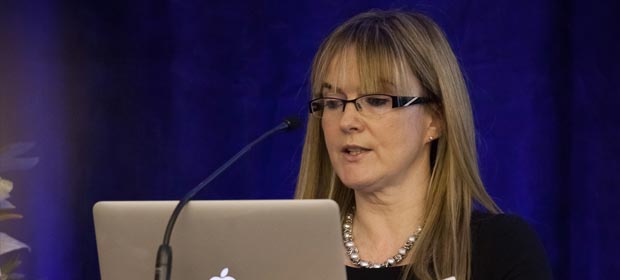The HSE National Clinical Programmes had nationalised existing best practice, engaged patients, aligned stakeholders, implemented vital new services, reduced the length of hospital stay, cut waiting lists and saved considerable amounts of money, Dr. Aine Carroll, National Director, Clinical Strategy & Programmes, HSE, told the Conference.
The HSE National Clinical Programmes had nationalised existing best practice, engaged patients, aligned stakeholders, implemented vital new services, reduced the length of hospital stay, cut waiting lists and saved considerable amounts of money, Dr. Aine Carroll, National Director, Clinical Strategy & Programmes, HSE, told the Conference.

There had, she said, been a revolution in healthcare from 1970 when there was an emphasis on doing things cheaper, to 1980 when it moved to doing things right to 1990 when the focus was on doing the right things right (evidence based medicine) to 2010 when we had the clinical Programmes.
Dr. Carroll said that the Programmes had made considerable achievements to date.
The National Clinical Programme for Acute Medicine had introduced the National Early Warning Score (NEWS) which received a public service excellence award from the Taoiseach, the total length of stay had been reduced by 21 per cent between 2005 and 2012 with the introduction of Acute Medical Assessment Units in every acute hospital and overnight length of stay had been reduced by eight per cent between 2005 and 2012.
The National Clinical Programme for Epilepsy had received an international nursing award for its description of the new national epilepsy service of Ireland.
Thrombolysis rates had increased from 2.4 per cent in 2007 to 9.5 per cent in 2013 exceeding targets and leaving Ireland with one of the highest rates in the world.
In the National Clinical Programme for Rheumatology/MSK, physiotherapy led musculo-skeletal clinics were reducing waiting lists by up to 70 per cent and 10,000 new patients had been triaged and treated from orthopaedic and rheumatology waiting lists in one year.
The National Clinical Programme for COPD had developed a COPD outreach model of care and pulmonary rehabilitation model of care, bundles of care and patient information materials, the average length of stay had been reduced from 9.1 days in 2009 to 7.6 in December 2012. Pulmonary rehabilitation was available in 37 sites, in 2012 access to pulmonary rehabilitation in 56 per cent of the sites had exceeded the target set and further work was ongoing to target areas without access.
The National Clinical Programme for Medicines Management had identified an additional two drugs as part of the “Preferred Drugs Initiative,” and the programme was aiming to secure €20 million in savings this year.
Work by the National Clinical Programme for Stroke meant that 27 out of 28 hospitals admitting patients with stroke requiring acute care now had a stroke unit, an increase from 18 in July 2010. Thrombolysis was available in all Model 3 and Model 4 hospitals, either directly or via ambulance access protocols. Thrombolysis rates had increased from 2.4 per cent in 2007 to 9.5 per cent in 2013 exceeding targets and leaving Ireland with one of the highest rates in the world. (UK is five per cent, Sweden 6.6 per cent and USA 2.4 per cent) There was a 2.5 per cent increase in patients discharged to home in 2011, a two per cent decrease in case fatality in 2011 and 2012 and a 2.9 per cent decrease in stroke nursing home admission.
The National Clinical Programme for Diabetes had commenced the national diabetes retinopathy screening and aimed to screen 30 per cent of the diabetic population this year. A national model of care to deliver CS11 therapy to children with Type 1 diabetes under five years had been developed and implemented.
The Retrieval & Transport Medicine Programme had extended neonatal retrieval to 24/7 nationally this year. Paediatric retrieval was due to begin a five day daytime service this year and the implementation of a national model for adult retrieval designed to support hospital groups was planned for early next year in Dublin, Cork and Galway, providing a seven day daytime service.
The National Clinical Programme for Audiology had introduced national screening of 99 per cent of children within four weeks of birth and the national Clinical Programme for Acute Coronary Syndrome had four 24/7 PCI centres operational.

